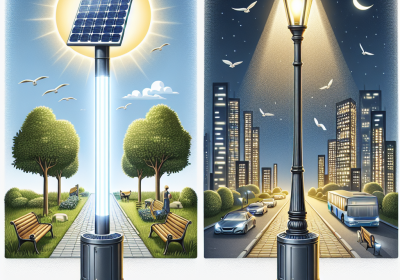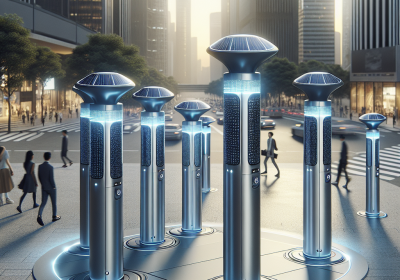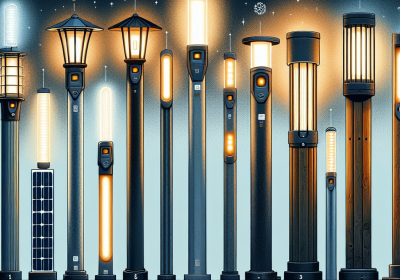From Safety to Sustainability: The Dual Benefits of Solar Bollards in Public Spaces
Have you ever walked through a park at night and felt reassured by the presence of lighted pathways? Or perhaps you’ve driven through a residential area where traffic-calming measures ensure pedestrian safety? Now, imagine if these solutions were not only effective but also environmentally friendly. Enter solar bollards, the unsung heroes of public spaces. In this article, we’ll dive into how these innovative devices offer both safety and sustainability, revolutionizing our approach to urban design.
What are Solar Bollards?
Solar bollards are sturdy, vertical posts equipped with solar panels and lighting fixtures. They serve multiple functions—from lighting pathways to protecting pedestrians from traffic. What sets them apart is their ability to harness solar energy, eliminating the need for electrical grid connections.
The Rising Popularity in Public Spaces
Across the globe, from the busy streets of New York to the serene parks of Tokyo, solar bollards are becoming a common sight. Their adoption is driven by the dual benefits they offer, which we will explore in detail.
Why focus on solar bollards?
Because they encapsulate the transition towards more sustainable urban environments while enhancing public safety. Let’s uncover the depth of these benefits and understand how they are achieved.
Understanding Solar Bollards
How Do Solar Bollards Work?
Solar bollards consist of solar panels, batteries, LED lights, and control electronics. During the day, the solar panels collect sunlight, converting it into electrical energy stored in batteries. At night, this energy powers the LED lights, providing illumination without tapping into the electrical grid.
Types of Solar Bollards
Not all solar bollards are created equal. Some are designed purely for lighting, while others are robust enough to withstand vehicle impacts, ideal for traffic control. The choice of bollard depends on its intended use in public spaces.
Technological Advancements
Recent innovations include improved battery life, more efficient solar panels, and smarter light control technologies that adjust brightness based on the time of night and pedestrian traffic. These advancements enhance the functionality and reliability of solar bollards.
Safety Benefits
Enhanced Visibility
Imagine a foggy evening; visibility is low, and the risks are high. Solar bollards provide crucial lighting, making pathways and crossings visible and safe. Studies show that well-lit areas significantly reduce the risk of accidents, especially at night.
Traffic Control and Pedestrian Safety
In urban areas, solar bollards act as gentle guardians—guiding vehicles, calming traffic, and protecting pedestrians. Their strategic placement can effectively prevent accidents and ensure a safe passage for pedestrians, particularly in areas with high foot traffic.
Emergency Readiness
What happens during a power outage? Unlike traditional lighting, solar bollards remain operational, providing essential lighting during emergencies and enhancing overall community resilience.
Sustainability Benefits
Energy Efficiency
Solar bollards require zero electricity from the grid, operating solely on solar energy. This not only cuts energy costs but also reduces dependency on non-renewable power sources, making them an eco-friendly lighting solution.
Reducing Carbon Footprint
By opting for solar bollards, communities can significantly lower their carbon emissions. Each solar bollard installed is a step towards a greener planet. Can you imagine the impact if every public space made this switch?
Longevity and Maintenance
Solar bollards are designed for durability and require minimal maintenance compared to traditional lighting. Their long lifespan and low upkeep make them a cost-effective solution over time.
Case Studies
Global Implementations
Cities like San Francisco and Stockholm have embraced solar bollards, integrating them into their urban landscapes. These case studies highlight the successful application and noticeable benefits in safety and sustainability.
Success Stories
Feedback from these cities shows increased public approval and enhanced quality of life. The reduction in light pollution and the increase in safety have been particularly praised.
Lessons Learned
Adopting solar bollards is not without challenges. However, the lessons learned from initial implementations have paved the way for more effective and widespread use.
Challenges and Considerations
Installation and Maintenance
While installation is straightforward, it requires careful planning to ensure optimal sunlight exposure and functionality. Maintenance, although minimal, must be consistent to maintain efficiency.
Cost and Funding
The initial investment for solar bollards can be high. However, long-term savings on energy and maintenance can offset these costs. Finding funding through grants and public-private partnerships is often crucial.
Community Engagement
Gaining community support is essential. Informing and involving local residents in the planning process can help mitigate resistance and increase acceptance.
Future Prospects
Technological Innovations
Ongoing research and development promise even more efficient and adaptable solar bollard designs in the future. What new features can we expect? Perhaps more interactive and integrated smart-city applications.
Expanding Applications
Solar bollards have potential beyond parks and streets. Imagine their benefits in remote areas without reliable power infrastructure.
Policy and Awareness
As awareness of their benefits grows, so will policy support, likely leading to broader adoption and standardized practices in urban planning.
Solar bollards offer a compelling example of how innovation can meet the dual demands of safety and sustainability in urban design. Their increasing integration into public spaces is a testament to their value and effectiveness.
FAQs
Q: How do solar bollards handle extreme weather? A: Solar bollards are built to withstand various weather conditions, from intense sun to heavy rain and snow. Manufacturers typically design them with durable materials and weatherproofing features.
Q: Are solar bollards effective in areas with low sunlight? A: Yes, modern solar bollards are equipped with high-efficiency panels that can charge even under low-light conditions.
Q: Can solar bollards replace streetlights? A: While they are not a replacement for all streetlighting needs, they are perfect for lighting smaller areas and pathways effectively.
Q: How long do solar bollards last? A: With proper maintenance, solar bollards can last up to 10-15 years or more.
By understanding and embracing solar bollards, communities around the world can enhance their public spaces’ safety and sustainability. Let’s support and promote the adoption of these smart solutions in our neighborhoods to pave the way for a brighter, greener future.









